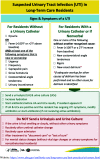Bacteriuria in older adults triggers confusion in healthcare providers: A mindful pause to treat the worry
- PMID: 36714291
- PMCID: PMC9879885
- DOI: 10.1017/ash.2022.343
Bacteriuria in older adults triggers confusion in healthcare providers: A mindful pause to treat the worry
Abstract
The evidence base for refraining from screening for or treating asymptomatic bacteriuria (ASB) in older adults is strong, but both practices remain prevalent. Clinical confusion over how to respond to a change from baseline, when to order a urinalysis and urine culture, and what to do with a positive urine culture fuels unnecessary antibiotic use for ASB. If the provider can take a mindful pause to apply evidenced-based assessment tools, the resulting increased clarity in how to manage the situation can reduce overtreatment of ASB.
© The Author(s) 2023.
Figures


References
-
- Ashraf MS, Gaur S, Bushen OY, et al. Diagnosis, treatment, and prevention of urinary tract infections in postacute and long-term care settings: a consensus statement from AMDA’s Infection Advisory Subcommittee. J Am Med Dir Assoc 2020;21:12–24. - PubMed
-
- Nicolle LE, Gupta K, Bradley SF, et al. Clinical practice guideline for the management of asymptomatic bacteriuria: 2019 update by the Infectious Diseases Society of America. Clin Infect Dis 2019;68:e83–e110. - PubMed
-
- Assessment and management of the resident with a suspected urinary tract infection. Agency for Healthcare Research and Quality website. https://www.ahrq.gov/antibiotic-use/long-term-care/best-practices/uti-as.... Accessed December 13, 2022.
Publication types
LinkOut - more resources
Full Text Sources
